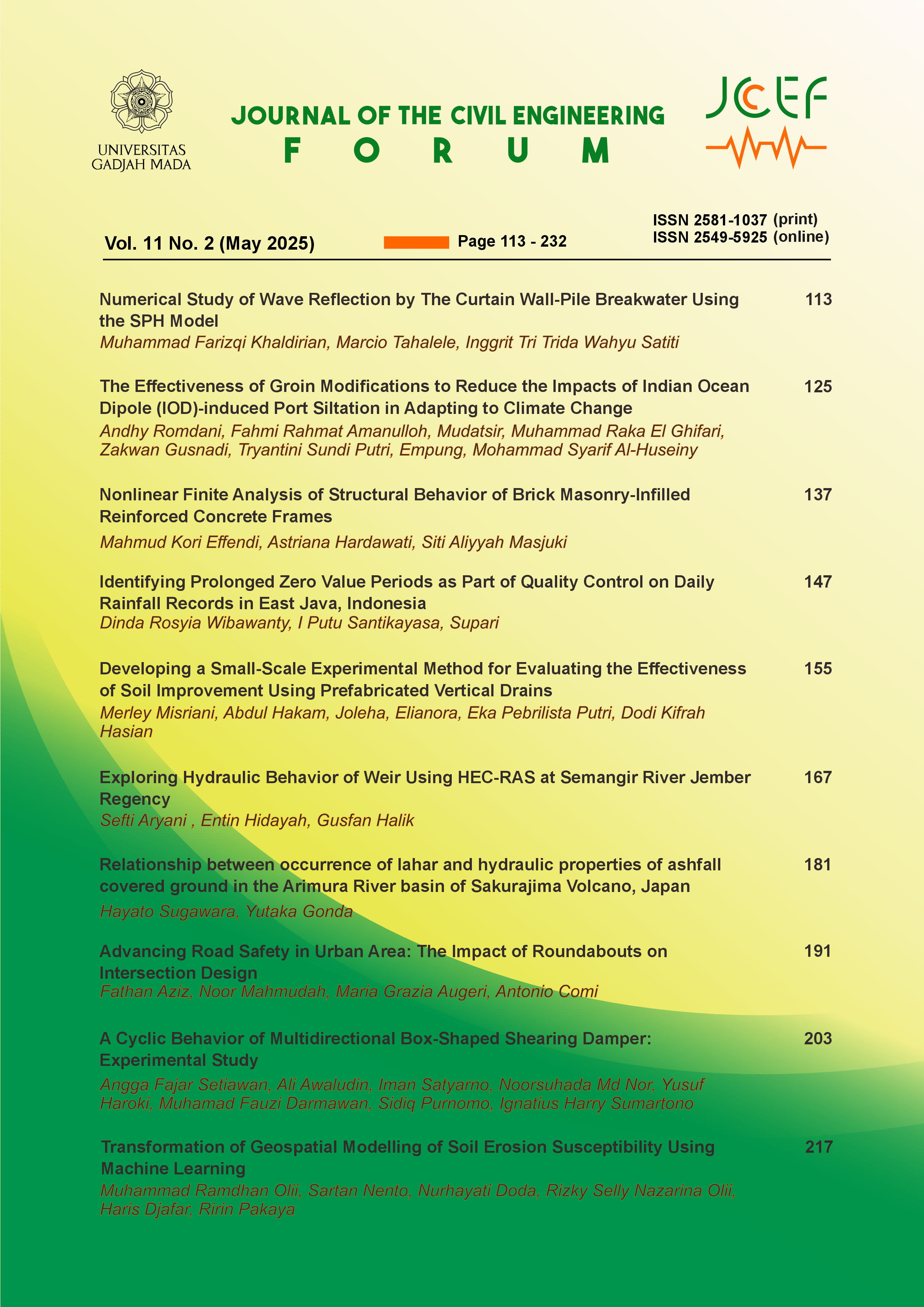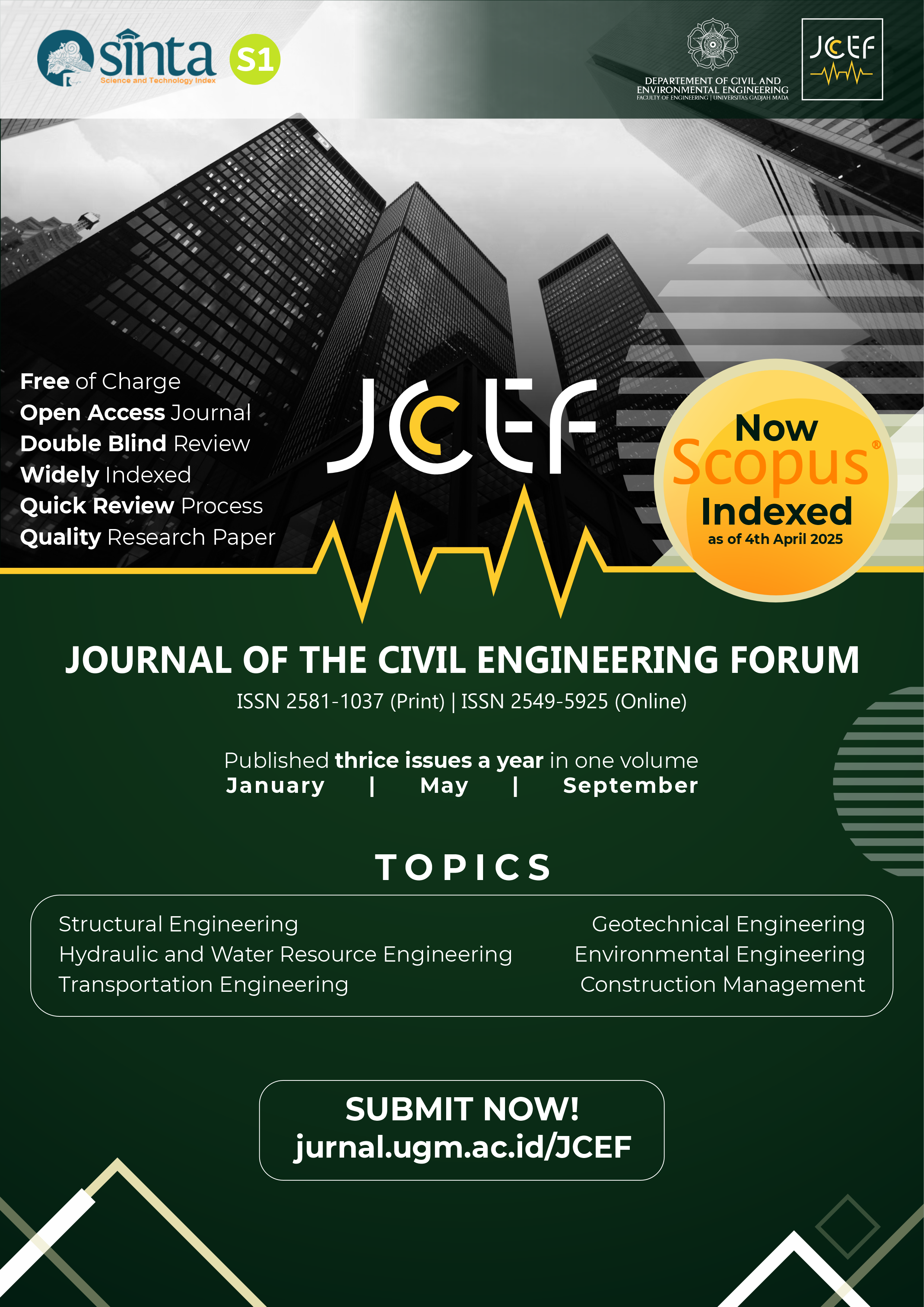The Effectiveness of Groin Modifications to Reduce the Impacts of Indian Ocean Dipole (IOD)-induced Port Siltation in Adapting to Climate Change
Abstract
Climate anomalies significantly affect coastal hydrodynamics, influencing sediment transport processes. The interaction between waves and currents plays an important role in sediment transport, which is closely related to climate anomalies, particularly the Indian Ocean Dipole (IOD). Indonesia is currently facing severe threats from port siltation due to the impacts of climate change. Port siltation results from sediment transport and can reduce the effectiveness and safety of port activities. This study aims to investigate sediment transport processes at Titan Coal Port under the influence of the IOD in 2016 and 2019. This port is located on the western coast of Sumatera, where high waves from the Indian Ocean pose a risk. Groins and a breakwater have been installed to protect the port from littoral drift induced by southeastern longshore currents and waves. However, the study found that during the negative IOD in 2016, hydrodynamic conditions led to shallowing of the port basin and navigation channel due to longshore currents from the northeast. The methods used in this research include descriptive analysis (using ERA-5 data from the Copernicus Climate Change Service) and numerical modeling (using MIKE 21) with bed level change identification at several points after groin modification scenarios. The combination of tidal currents and waves primarily shaped current patterns in the study area. High-speed currents caused significant erosion upstream at the bed level of the port basin. However, modified groin installations effectively reduced flow velocity entering the port basin. Two modified groin installation scenarios were tested in the study area to alter existing coastal hydrodynamics and sediment transport patterns.
References
Abdelhafez, M. A., Ellingwood, B., & Mahmoud, H. (2021). Vulnerability of seaports to hurricanes and sea level rise in a changing climate: A case study for mobile, AL. Coastal Engineering, 167, 103884. https://doi.org/10.1016/j.coastaleng.2021.103884
Afentoulis, V., Papadimitriou, A., Belibassakis, K., & Tsoukala, V. (2022). A coupled model for sediment transport dynamics and prediction of seabed morphology with application to 1DH/2DH coastal engineering problems. Oceanologia, 64(3), 514–534. https://doi.org/10.1016/j.oceano.2022.03.007
Badan Informasi Geospasial. (2024). BATNAS [Dataset]. https://tanahair.indonesia.go.id/portal-web/unduh/batnas
Bianchini, A., Cento, F., Guzzini, A., Pellegrini, M., & Saccani, C. (2019). Sediment management in coastal infrastructures: Techno-economic and environmental impact assessment of alternative technologies to dredging. Journal of Environmental Management, 248, 109332. https://doi.org/10.1016/j.jenvman.2019.109332
Boyden, P., Casella, E., Daly, C., & Rovere, A. (2021a). Hurricane Matthew in 2100: Effects of extreme sea level rise scenarios on a highly valued coastal area (Palm Beach, FL, USA). Geo-Marine Letters, 41(4), 43. https://doi.org/10.1007/s00367-021-00715-6
DHI, D. H. I. (2021). MIKE FLOOD: Urban, coastal, and riverine flooding. https://www.mikepoweredbydhi.com/products/mike-flood
DHI Water & Environment. (2006). MIKE 21 Flow Model: Hydrodynamic Module User Guide. https://www.dhigroup.com/technologies/mikepoweredbydhi/downloads-and-support
Dong, W. S., Ismailluddin, A., Yun, L. S., Ariffin, E. H., Saengsupavanich, C., Abdul Maulud, K. N., Ramli, M. Z., Miskon, M. F., Jeofry, M. H., Mohamed, J., Mohd, F. A., Hamzah, S. B., & Yunus, K. (2024). The impact of climate change on coastal erosion in Southeast Asia and the compelling need to establish robust adaptation strategies. Heliyon, 10(4), e25609. https://doi.org/10.1016/j.heliyon.2024.e25609
Humphreys, R. M. (2023). Why ports matter for the global economy. https://blogs.worldbank.org/en/transport/why-ports-matter-global-economy
IPCC (Intergovernmental Panel on Climate Change). (2007). Climate Change 2007: Working Group II: Impacts, Adaptation and Vulnerability.
Irmawan, M., Imaaduddiin, M. H., Alam, R. R. R., Refani, A. N., & Aini, A. N. (2024). Hydrodynamic Analysis-Based Modeling of Coastal Abrasion Prevention (Case Study: Pulau Baai Port, Bengkulu). Applied Sciences, 14(2), 940. https://doi.org/10.3390/app14020940
Izaguirre, C., Losada, I. J., Camus, P., Vigh, J. L., & Stenek, V. (2021). Climate change risk to global port operations. Nature Climate Change, 11(1), 14–20. https://doi.org/10.1038/s41558-020-00937-z
Jouili, T., & Allouche, M. (2016). Impacts of Seaport Investment on the Economic Growth. Promet - Traffic - Traffico, 28, 365–370.
Marfai, M. A. (2012). Preliminary assessment of coastal erosion and local community adaptation in Sayung coastal area, central java – Indonesia. Quaestiones Geographicae, 31(3), 47–55. https://doi.org/10.2478/v10117-012-0028-2
Mclean, E. L., & Becker, A. (2021). Advancing Seaport Resilience to Natural Hazards Due to Climate Change: Strategies to Overcome Decision Making Barriers. Frontiers in Sustainability, 2. https://doi.org/10.3389/frsus.2021.673630
MIKE 21 & MIKE 3 Flow Model FM - Sand Transport Module. (n.d.).
Munim, Z. H., & Schramm, H.-J. (2018). The impacts of port infrastructure and logistics performance on economic growth: The mediating role of seaborne trade. Journal of Shipping and Trade, 3(1), 1. https://doi.org/10.1186/s41072-018-0027-0
Portillo Juan, N., Negro Valdecantos, V., & del Campo, J. M. (2022). Review of the Impacts of Climate Change on Ports and Harbours and Their Adaptation in Spain. Sustainability, 14(12). https://doi.org/10.3390/su14127507
United Nations. (2024). The 17 Goals. https://sdgs.un.org/goals
United Nations Conference on Trade and Development. (2021). Review of Maritime Transport 2021. https://doi.org/10.18356/9789210000970
Van Rijn, L. C. van. (2016). Harbour siltation and control measures. https://www.leovanrijn-sediment.com/papers/Harboursiltation2012.pdf
Wang, X. H., & Andutta, F. P. (2013). Sediment Transport Dynamics in Ports, Estuaries and Other Coastal Environments. In A. J. Manning (Ed.), Sediment Transport. IntechOpen. https://doi.org/10.5772/51022
Wardani, K. S., & Murakami, K. (2019). The Effectiveness of Groin System on the Control of Sediment Transport. Journal of Japan Society of Civil Engineers, Ser. B2 (Coastal Engineering), 75(2), I_535-I_540. https://doi.org/10.2208/kaigan.75.I_535
World Economic Forum. (2019). Port infrastucture quality-Country rankings. www.theglobaleconomy.com/rangkings/seaports_quality/
Zhang, L., Du, Y., & Cai, W. (2018). Low-Frequency Variability and the Unusual Indian Ocean Dipole Events in 2015 and 2016. Geophysical Research Letters, 45(2), 1040–1048. https://doi.org/10.1002/2017GL076003
Copyright (c) 2025 The Author(s)

This work is licensed under a Creative Commons Attribution-ShareAlike 4.0 International License.
Copyright is granted to authors for the purpose of providing protection for articles written to describe experiments and their results. JCEF will protect and defend the work and reputation of the author and are also willing to address any allegations of violation, plagiarism, fraud, etc. against articles written and published by JCEF. JCEF is published under the terms of the Creative Commons Attribution-ShareAlike 4.0 International License (CC BY-SA 4.0). The author holds the copyright and assigns the journal rights to the first publication (online and print) of the work simultaneously.





